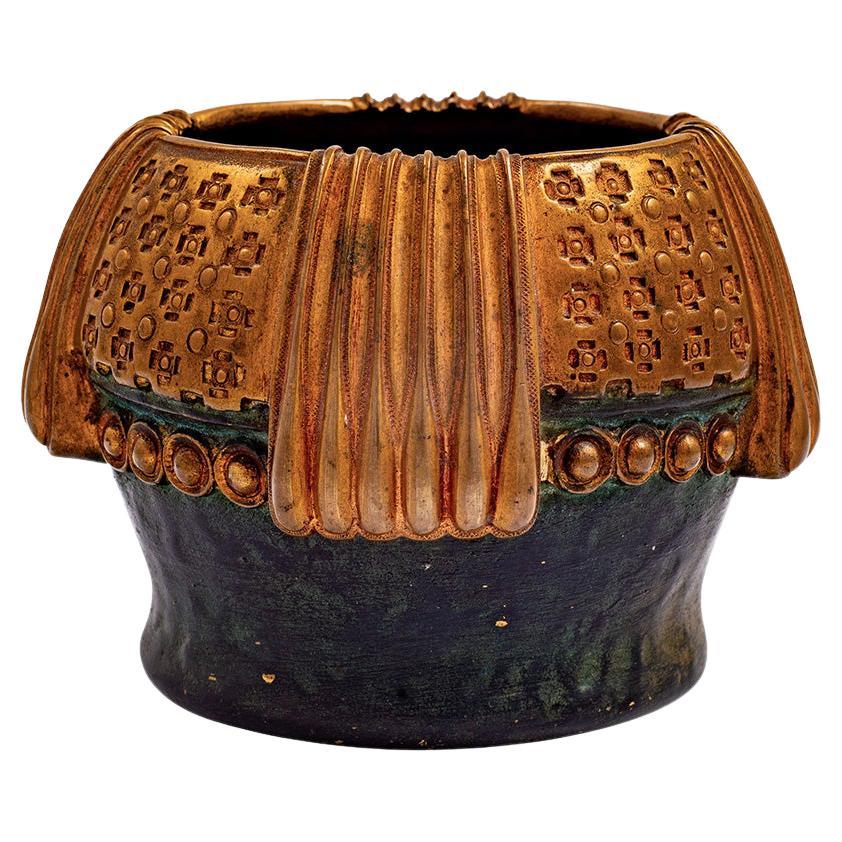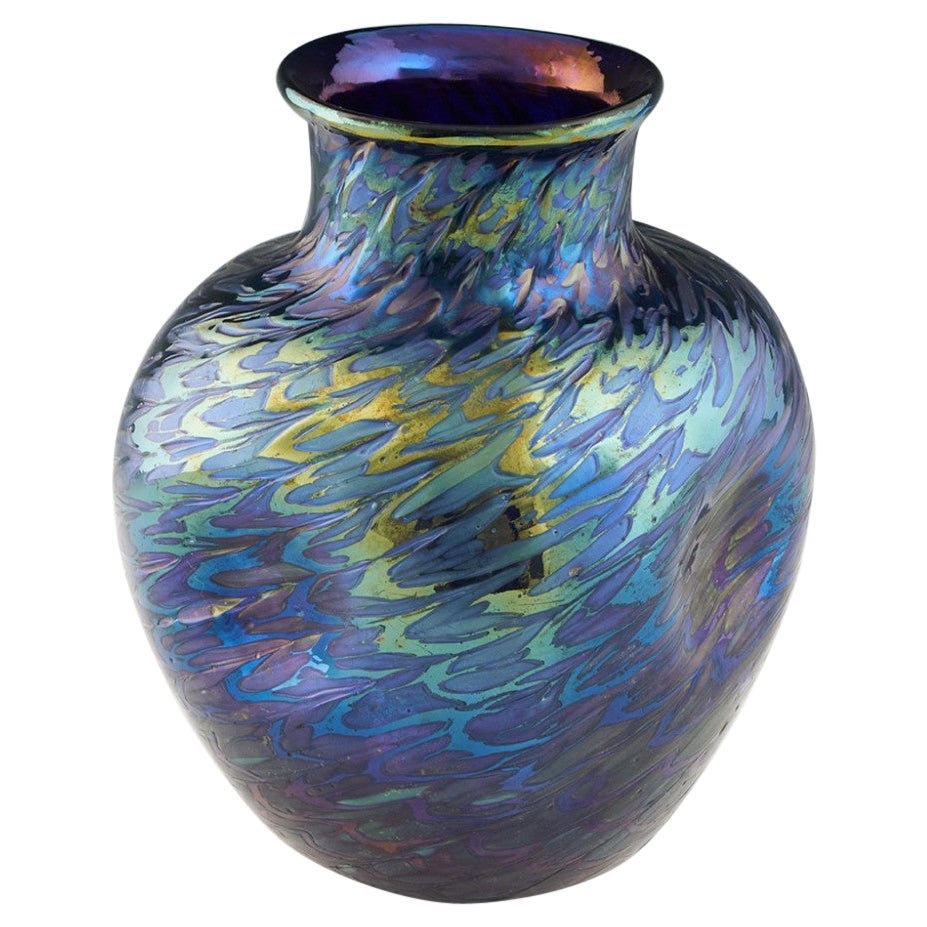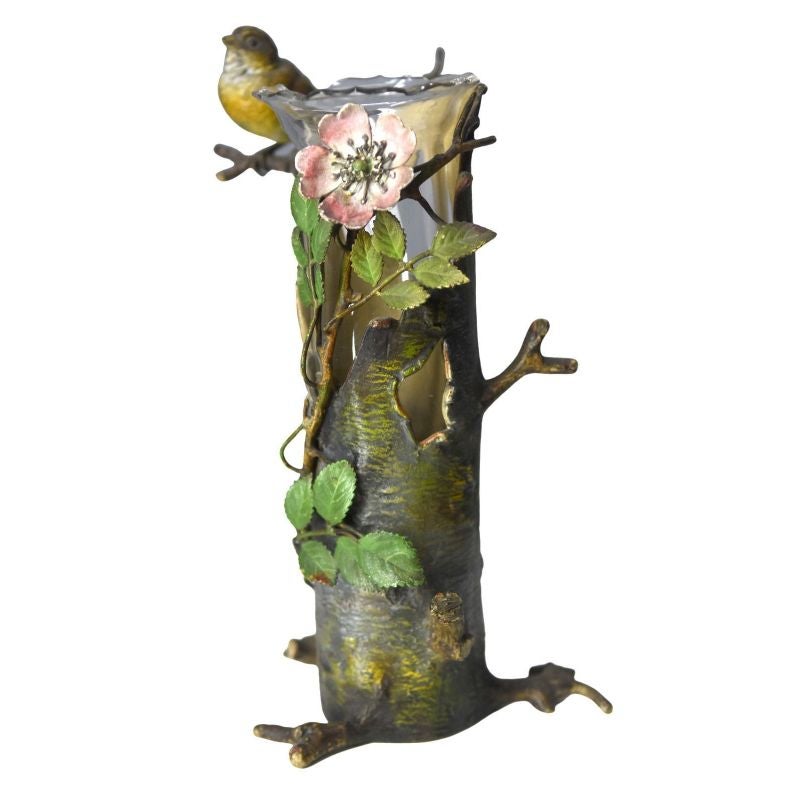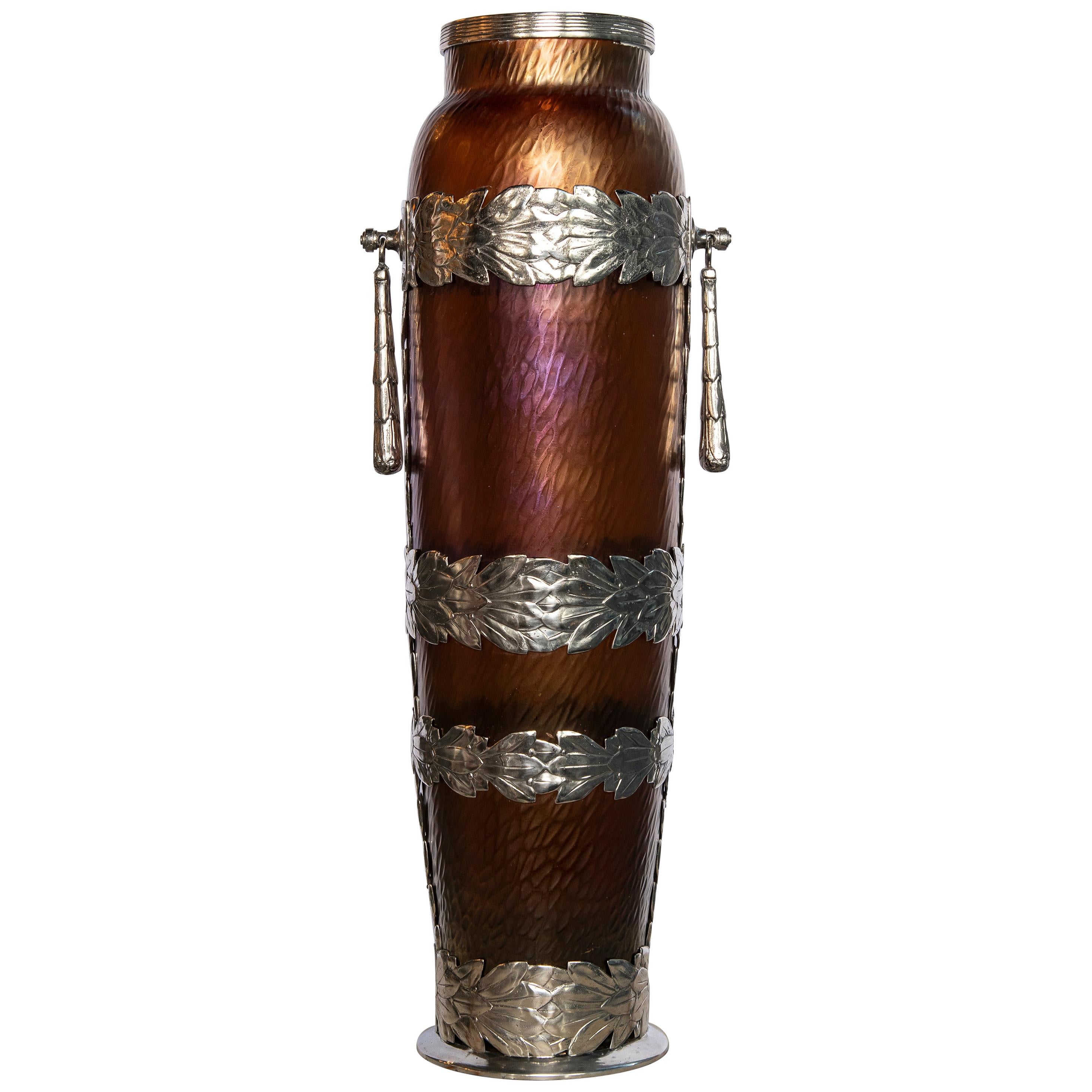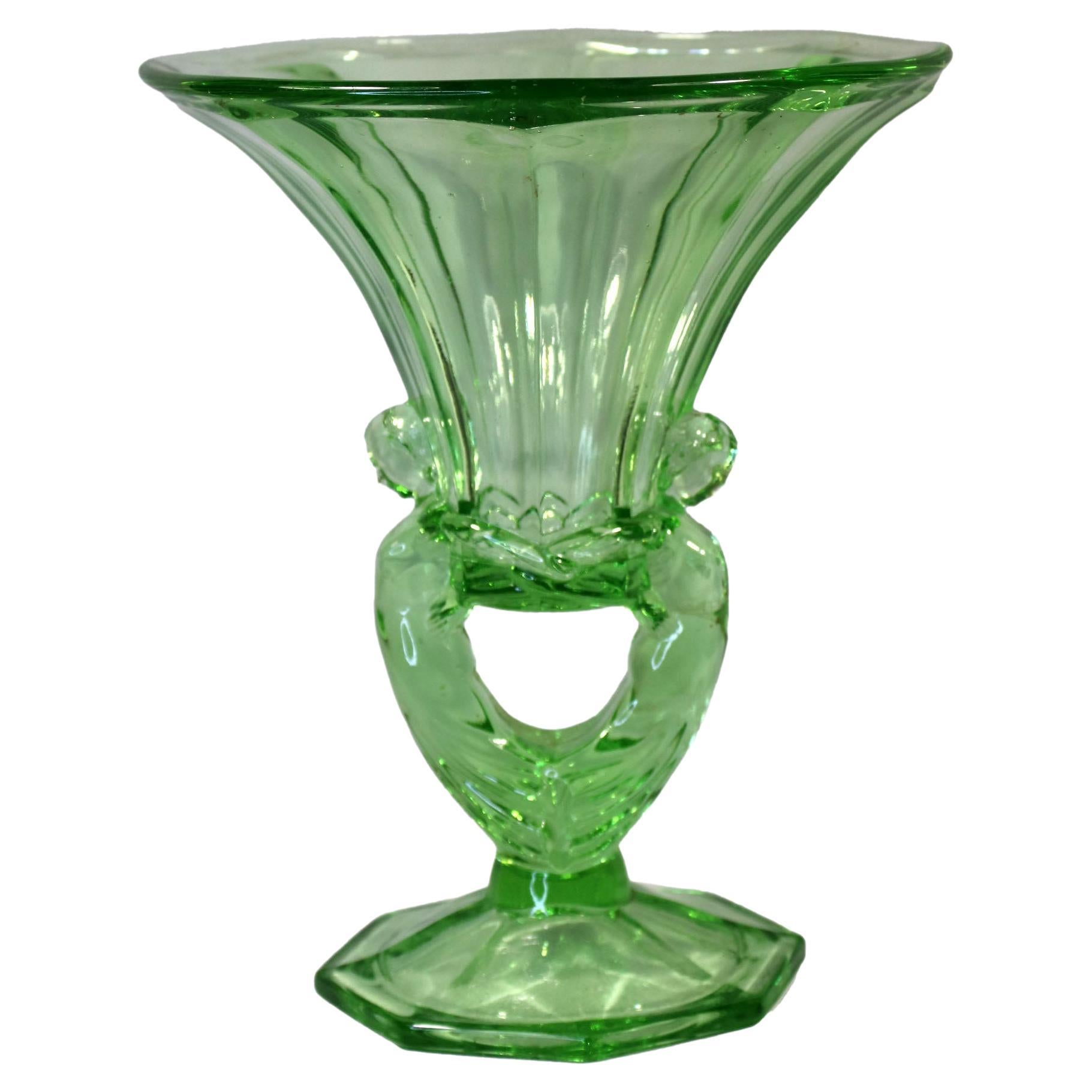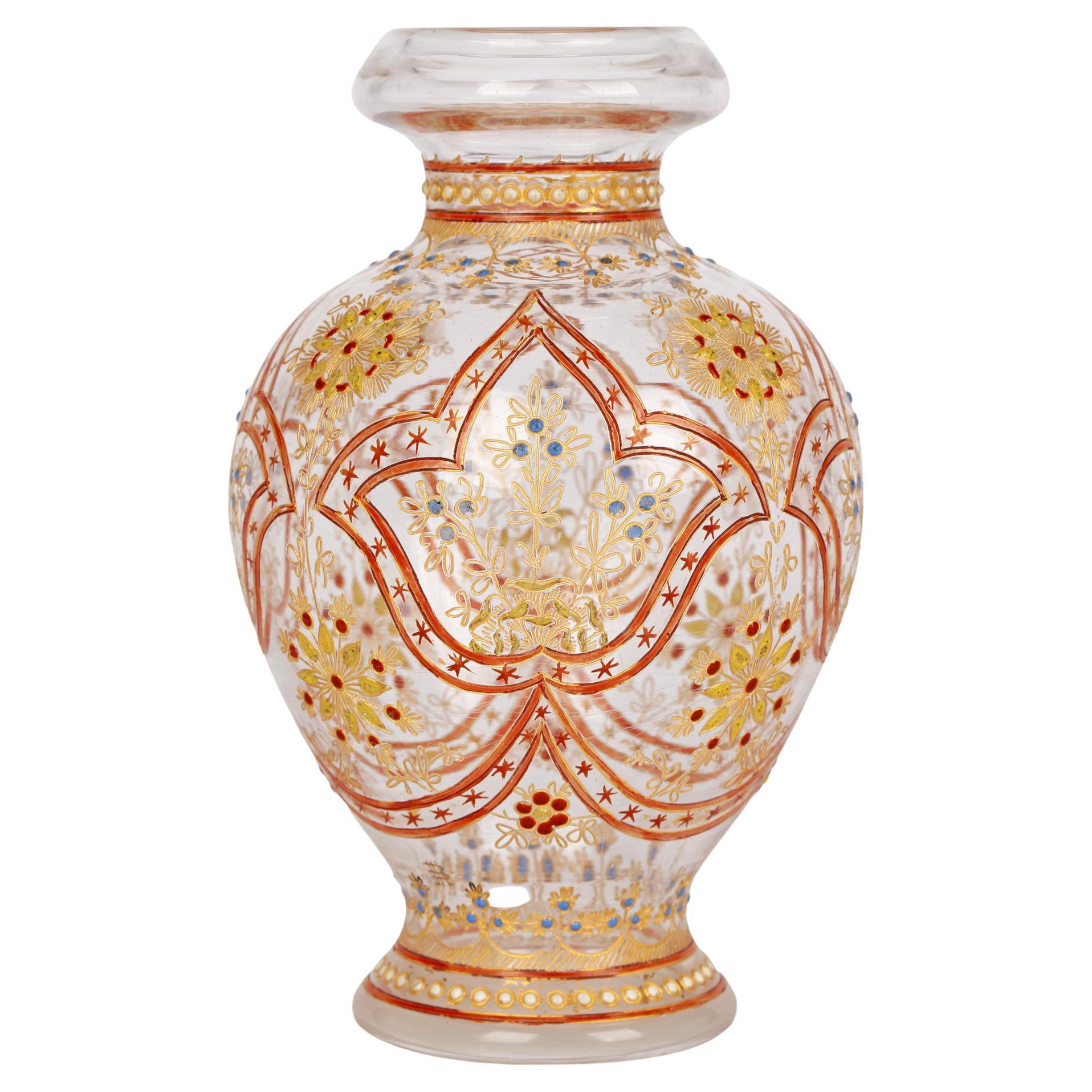Items Similar to Alfonso Canciani, Viennese Secession Orientalist Bronze Vase, c. 1910
Want more images or videos?
Request additional images or videos from the seller
1 of 12
Alfonso Canciani, Viennese Secession Orientalist Bronze Vase, c. 1910
About the Item
Alfonso Canciani (Italian-Austrian, 1863-1955) was a famous Italian-Austrian sculptor of the period of accession to the Viennese Secession. Son of a stonemason, after a realist period he managed to establish himself as a leading sculptor of the Viennese Secession. In fact, he worked in Vienna, where he had enrolled in 1886 at the Academy of Fine Arts, then at the Higher School of Sculpture and finally at the Special School, where he obtained the Rome prize for the sketch for Dante's Monument.
He developed a notable business obtaining important prizes and numerous commissions. First among the sculptors of the Viennese capital, he was invited to join the Association of the Viennese Secession, of which Klimt was magna pars, after the exhibition of Dante's group in 1900 at the Secession exhibition, and obtained the most important Austrian artistic prize, the Kunstlerlpreis.
This same work, presented in 1910 in Berlin, at the Great Art Exhibition, also received an important recognition here. He obtained the Rome prize in 1896, exhibited successfully in Munich and in 1899 at the III International Art Exhibition in Venice.
In that period he made some statues of saints for the cathedral of Santo Stefano in Vienna, the monument to Wagner, the bust of Nietzsche for the University, the scepter and the gold chain of the University Rector, figures of Italian poets ( Petrarch, Boccaccio, Tasso, Ariosto).
He submitted a sketch for the official monument to Empress Elizabeth, which was then built in Austrisn Gföhl and Pula. At the time of his accession to the Secession, he dedicated himself to decorating the facade of the Artaria house in Vienna in collaboration with the architect Max Fabiani.
He later abandoned the symbolist decorativism of the Jugendstil for a more concentrated and vigorous style, approaching the Belgian sculptor Constantin Meunier for the theme of work, and preferring to exhibit at the Künstlerhaus.
In Vienna, he was generous with advice and help with the Italians and in particular with his fellow citizens (such as the Brazzanese Luigi Visintin, then a university student).
After the First World War, he returned to Italy and lived in Friuli, penalized by the fact that the Habsburg Empire had by now disappeared. Instead of large-scale public monuments, he then devoted himself to engraving medals (e.g. for Benedict XV and for the Italian mission in Vienna in 1919) and to designing funeral monuments (examples in Mali Lošinj and Trieste) and portrait busts (of Generals Carlo Caneva and Antonio Baldissera in Udine, sculptures of the War Memorial of Corno di Rosazzo). After all, he had already executed the Bab grave monument in the Döblinger cemetery in Vienna in 1909.
He taught in Trieste from 1920 until 1935, at the local school of industrial art, where he had Marcello Mascherini as a student. However, his activity remained remarkable, so much so that in 1940 he received the prize from the Italian Academy of Fine Arts. In particular, small and large statues inspired by the world of work are remembered, which he knew how to recreate with authenticity by identifying himself with the spirit of the workers (e.g. Friulan miner, fire worker, smelters), just as Domenico Rambelli was able to do.
Canciani’s dynamic statue by Lanciasassi is placed in the central square of Cormons. Also in Cormons, in the Town Hall building, there is a museum dedicated to Alfonso Canciani, which contains numerous works donated by his daughter on the occasion of an exhibition in honor of her father.
The Madonna on the facade of the cathedral of Gorizia is one of his works, as well as under the loggia of the Lionello of Udine the busts of generals Caneva and Baldissera. Other works by him can be found in the Civic Museum in Gorizia and in the Osterreichisches Museum fur Angewandte Kunst in Vienna and in various private collections. Various retrospectives were dedicated to Alfonso Canciani’s art, containing the most manageable works, as well as photos of public monuments.
- Creator:Alfonso Canciani (Sculptor)
- Dimensions:Height: 7.25 in (18.42 cm)Width: 7 in (17.78 cm)Depth: 7 in (17.78 cm)
- Style:Jugendstil (Of the Period)
- Materials and Techniques:Bronze,Cast
- Place of Origin:
- Period:1910-1919
- Date of Manufacture:circa 1910
- Condition:Wear consistent with age and use. We make our best effort to provide a fair and descriptive condition report. Please examine photos attentively, as they are an integral part of the description. Send us a message to request more details or discuss price.
- Seller Location:New York, NY
- Reference Number:1stDibs: LU2819331888472
About the Seller
5.0
Vetted Seller
These experienced sellers undergo a comprehensive evaluation by our team of in-house experts.
Established in 1993
1stDibs seller since 2017
68 sales on 1stDibs
Typical response time: 2 hours
- ShippingRetrieving quote...Ships From: New York, NY
- Return PolicyA return for this item may be initiated within 10 days of delivery.
More From This SellerView All
- Franz Xavier Bergmann, Sculptural Bud Vase, Vienna Bronze, circa 1900By Franz BergmannLocated in New York, NYDimensions Height: 7.25 inches Width: 5.25 inches Depth: 4.5 inches. Markings Fully marked on the bottom with a "B" in an urn-shaped cartouche (for “Bergmann”), and “GESHUTZED” (German: “PROTECTED). ABOUT What distinguishes this unique bud vase from others is a perfect synthesis of a utilitarian object and a Fine sculpture. It is not only the amazing subtlety and taste of the author’s artist skills, but an extraordinary design and an absolutely outstanding original plot. Designed for a single flower only, it is nonetheless a very complex and multifaceted composition filled with warm humor and fantasy. Sitting on a vessel shaped as a gourd, clasping its goat legs with hooves and holding on to the neck with one hand in order not to fall of it; a playful and mischievous faun holds by the tail a fleeing lizard with the other hand. FRANZ XAVIER BERGMANN (Austrian, 1861–1936) was the owner of a Viennese foundry who produced numerous patinated and cold-painted bronze oriental, erotic and animal figures, the latter often humanized or whimsical, humorous objects d'art. Cold painted bronze refers to pieces cast in Vienna and then decorated in several layers with so-called dust paint; the expertise for the mix of this kind of paint has been lost. The color was not fired hence "cold painted". Mainly women working...Category
Antique Early 1900s Austrian Jugendstil Vases
MaterialsBronze
- French Art Nouveau Patinated Bronze Sculptural Iris Vase, ca. 1900Located in New York, NYABOUT IRIS The iris is a special and mysterious flower. Not only because of its striking appearance, but also from an artistic and historical point of view. It is also like a work of art, as though created by Mother Nature. The unique leaves of this plant not only create wonderful shadow casts, but also look as if they were painted by hand. It's no wonder that iris acts as the muse for countless artists, and can be seen in many famous works of art. The iris was first spotted in the time of Pharaoh Thutmose, in 1504 BC. He had the iris inscribed into the wall reliefs of a temple as a sign of his power, as well as decorating his sceptre with motifs of the flower. Since then, the iris has been a symbol of victory in Egypt. But the symbolism of the iris goes further than that. In Japan, the flower represents courage and is the symbol of the boys' festival. In Islamic cultures, the iris is a symbol of prosperity. In Europe, the flower was a popular weapon symbol in the Middle Ages and stood for chivalry. And in Christianity, the iris was seen as a symbol of the trinity because of its three-part flowers. With more than 300 varieties, the iris is now the most popular flower among growers and gardeners following the rose. Countless artists use the iris in their works and the flower is present in all eras. You can see the flower on furniture, vases, jewelry, fabrics, sculptures, coats of arms and much more. Did you know that the iris is also called the sword lily? It's not a coincidence that it used to symbolize physical and emotional pain and suffering caused by a weapon. We also see the flower in religious art, where it's often associated with Mary and Jesus. The iris is also associated with the Greek goddess Iris, where the flower symbolizes reconciliation and divine messages. This is also reflected in many paintings. Finally, the iris is also visible in Dutch and Flemish still-life paintings. This can be in a religious form, incorporated into an object or as a decorative flower. In the Art Nouveau art movement, the iris (along with other plants, such as the birch) was often used as an expression of feminine beauty. With its almost otherworldly appearance, the iris is perfectly suited to the Art Nouveau aesthetic and is featured in many well-known works of art. The poet of that era, Hermann Hesse...Category
Antique Early 1900s French Art Nouveau Planters, Cachepots and Jardinières
MaterialsBronze
- Japanese Art Nouveau Meiji Period Patinated Bronze Vase, circa 1900Located in New York, NYAlthough unmarked, this rare and important, grand but at the same exquisite patinated bronze vase has just a very few little details, defying the shape of the handles, as well as the...Category
Antique Early 1900s Japanese Art Nouveau Vases
MaterialsBronze
- Charles Vital-Cornu, French Art Nouveau Bronze Sculptural Floral Vase, 1900sBy Charles Vital-CornuLocated in New York, NYCharles Vital-Cornu (French, 1851 - 1927), Jouffroy’s and Pils’ pupil, he acquired a skillfulness mastery in carving marbles and producing bronzes. He used several patinas in his production. Indeed, if his pieces' embodiments are often golden-brown colored, the hollow part are darker. His figures, hands, faces, and bodies are of a great quality. Charles Vital-Cornu had participated in numerous annual ‘‘Salons’’ organized in Paris by ‘‘la Société des Artistes Français’’ where he got several awards, such as a mention of Honor in 1880 and 1881, a third class medal in 1882, a travelling grant in 1883, a second class medal in 1886, a bronze medal at the 1889 World Fair and, finally, a silver medal at the 1900 World Fair at the Grand palace...Category
Antique Early 1900s French Art Nouveau Vases
MaterialsBronze
- French Art Nouveau Iridescent Stoneware & Bronze Vase or Cachepot, ca. 1900sLocated in New York, NYFrench Art Nouveau Ocean Life Theme Vase Cachepot Iridescent Stoneware & Patinated Bronze Crab Appliqué ca. 1900s ABOUT We present here a most unusual and utterly decorative Fren...Category
Antique Early 1900s French Art Nouveau Vases
MaterialsStoneware
- Carl Kauba, Frightened by the Frog, Viennese Bronze Sculpture, circa 1915By Carl KaubaLocated in New York, NYDimensions Total Height: 7.5 inches Base Height: 2 inches Width: 2.75 inches Depth: 2.75 inches ABOUT This charming desk figurine in dark brown patinated Viennese bronze by the famous Austrian sculptor Karl Kaub stands out for the originality and humor of its subject matter. The author depicted with amazing subtlety a boy who jumped on one leg in fright, suddenly seeing a frog sitting on his arm. CARL KAUBA (Austrian, 1865-1922) was born August 13, 1865 in Vienna, Austria. The son of a shoemaker, Kauba chose to follow his calling into the world of art. Collectors now rank him in a class with Remington and Russell as one of the great portrayers of American Western. His subjects were typically American Indians, calvarymen, cowboys, and roughriders. In addition to his American bronzes, Kauba produced a lifetime’s worth of Austrian statuary. His work became fully appreciated on both sides of the Atlantic. Carl studied at the Academy of Fine Arts in Vienna under professor Laufenberg. Later he would study at the academies under Carl Waschmann and Stefan Schwartz. Next, he went to Paris in 1886 to further study before he set off for the U.S. In fact, some debate still remains as to whether Kauba ever visited the U.S. Kauba’s fascination with the West was fired by the stories of the German writer, Carl May, whose tales of Western adventure were well known throughout Europe. Most authorities feel that he was about twenty-five years old when he traveled widely throughout the American West. He then returned to Austria with voluminous notes, sketches, and several models of Western sculpture...Category
Vintage 1910s Austrian Jugendstil Figurative Sculptures
MaterialsBronze
You May Also Like
- Bronze Vase Gustav Gurschner circa 1910 Austrian JugendstilBy K.K. Kunst-Erzgiesserei Wien, Gustave GurschnerLocated in Klosterneuburg, ATBronze vase with cross relief designed by Gustav Gurschner manufactured by K.K. Kunst-Erzgiesserei Wien ca. 1910 Austrian Jugendstil signed Gust...Category
Vintage 1910s Austrian Jugendstil Vases
MaterialsBronze
- Vase Mounted by a Viennese Bronze Bird, XIXth CenturyLocated in Marseille, FRGlass vase mounted by a Vienna bronze representing a bird perched on a branch. XIXth century work. Dimensions height 22 cm. Unfortunately part of the glass rim is broken. Addition...Category
Antique 19th Century Vases
MaterialsBronze
- Kralik Fish Scales Vase, circa 1910By Wilhelm Kralik SohnLocated in Tunbridge Wells, GBKralik Fish Scales Vase, circa 1910 Additional Information: Date: c1910 Origin: Bohemia Bowl Features: Iridescent glass in a fish scale pattern, ...Category
20th Century Czech Jugendstil Jars
MaterialsGlass, Art Glass, Blown Glass
- Vase From The Secession PeriodLocated in Lučenec, SKThis beautifful smaragd green vase from the Vienna Secession period has an eye cathing shape and artwork. It is suitable for smaller flower bouquets with short stems. This vase will ...Category
Antique Early 1900s Austrian Vienna Secession Vases
MaterialsArt Glass
- Iridescent Glass and Silver Plate Vase, Germany, circa 1910Located in Buenos Aires, Buenos AiresIridescent glass and silver plate vase. Germany, circa 1910.Category
Vintage 1910s German Jugendstil Vases
MaterialsSilver Plate
- J & L Lobmeyr Viennese Enamelled Persian-Style Glass VaseBy J. & L. Lobmeyr CompanyLocated in Bishop's Stortford, HertfordshireA fine Austrian Viennese clear crystal glass vase delicately decorated with Persian style floral designs in jeweled enameling by J & L Lobmeyr and dating from around 1880. The small ...Category
Antique 1880s Austrian Art Nouveau Vases
MaterialsBlown Glass
Recently Viewed
View AllMore Ways To Browse
Antique Bedroom Theme
Secession Style
Orientalist Style
Small Vase Group
Entry Statue
Mali Furniture
Saint Elizabeth
Antique Vases From Austria
Belgium Vase Antique
Empire Bronze Vase
Antique Portrait Vase
Empire Style Vase
Furniture 1900 1910 1920
Cathedral Bronze
Italian Santos
Santos Italian
Antique Industrial Scale
Viennese 1910
